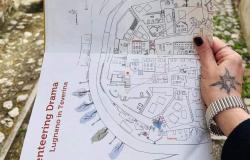In our interview with Adriano Pedrosaa few months before the start of his Biennial, we asked him if the rhetoric of foreigner is still necessary to talk about diversity: his non-answer (or rather, his talk of “points of view”) seemed eloquent to us. Strangers Everywhereit is a Biennial that celebrates the foreigner, in all its possible conformations: from those coming from the global South (therefore not from Western countries) to those who are part of the queer community, the merit of this Biennial is that it has managed to give a voice consistent, unprecedented in the history of this institution and in line with the trajectory traced by the outgoing president Roberto Cicutto, to over three hundred artists belonging to contexts underrepresented by the art system; in a word, to outsiders. If it is (almost) a novelty for the Venice Biennale, it is not however for other major events as documented in Kassel, which for more than twenty years (and in particular since its eleventh edition, curated by the late Okuwi Enwezor in 2002) explores the theme of decolonialism. But let’s get to the point, to understand whether the relative originality of the selected theme is supported by the artists and, above all, by the works.
“Foreigners Everywhere”. Adriano Pedrosa’s exhibition at the Venice Biennale
Even though it is the neon sign “Foreigners Everywhere / Stranierə Ovunque” by Claire Fontaine to introduce the exhibition at the Corderie dell’Arsenale (as well as at the Central Pavilion of the Giardini), it is shortly afterwards that what can easily be defined as the true manifesto of this Biennale appears: an imposing work by Frieda Toranzo Jaeger includes the major themes (and techniques) around which Pedrosa’s exhibition revolves. Painting and embroidery are in fact at the center of Toranzo Jaeger’s work, to tell the issues of decolonialism, of non-dichotomous love, of the freedom of peoples: in fact, there is no shortage of more or less explicit references to the Palestinian cause. He thus proceeds on these directives Strangers Everywhere, exploring the foreigner in the difficulty but also in the richness of his condition. If in certain passages, in particular at the Arsenale, it seems as if we are catapulted back in time to the 2022 edition curated by Cecilia Alemani, the same sensation cannot be found regarding the videos: too many and scattered two years ago, few and well-kept in this edition. Starting from the very valid Disobedience Archive by Marco Scotini, which deserves an article in itself: dozens of films that tell the story of civil disobedience are presented simultaneously, but the audio-visual buzz that pervades the room disappears when you concentrate on a single video, thanks to a set-up that is careful to avoid the overlap and cannibalization of contents. Also at the Arsenale are the films VOID of the Filipino Joshua Serafin And Torita-encuetada by the Nicaraguan Elyla, both dedicated to the exploration of queer identity through performances that involve the body in a ritual way, albeit with respectively science fiction and traditional meanings. In the Central Pavilion of the Gardens, the projection stands out Gaddafi in Rome: Anatomy of a Friendshipin which Alessandra Ferrini explores the contemporary reflections of the Italian colonialist past starting from the documentation relating to the meeting between Muammar Gaddafi and Silvio Berlusconi in 2008.
The article continues below
“Foreigners Everywhere”. The historical nucleus, in the footsteps of a new modernism
Among the greatest merits of the exhibition is the so-called historical nucleus: three sections that serve as the cornerstone of a process of rereading the past from a non-Western point of view. To the gardensthe sections Abstractions And Portraits they collect the experiences of a twentieth century not considered until now, except in the latitudes in which it developed. Works by artists from Asian, African, Central-South American and Oceanic contexts demonstrate the need to rethink the (geographic and temporal) coordinates of modernism. Self Abstractions And Portraits suffer from unfortunate arrangements, which are modeled on old and under-appreciating picture galleries, the same cannot be said of the section of the historic nucleus housed in the Arsenale and entitled Italians Everywhere: the works of Italian artists who have found a home abroad, outlining what was (and still is) a true diaspora, are exhibited on transparent glass panels, recovering an installation designed by Lina Bo Bardi specifically for the Museu de Arte de São Paulo in Brazil (of which Pedrosa is director). Among others, a work by Domenico Gnoli which shows the sole of a shoe (a usually invisible part, which echoes the historical invisibility of many of the artists exhibited in the exhibition and that of the back of the works, made visible precisely by the glass supports) and a painting by Umberto Giangrandi in which a still life is surrounded by a leaden sky and an embrace, perhaps of love, perhaps of violence.
“Foreigners Everywhere”. Lots of paint, little technology
Pedrosa’s exhibition is also aligned with the transavant-garde reverberations (or skeletons) that characterize the present of international contemporary art. Beyond its foreseeable presence in the historical nucleus, the painting seems to continue to be the favorite medium of the vast majority of the selected artists, not only in the Central Pavilion of the Giardini, but also in the Arsenale, where the spaces could favor (as has happened in the past) interventions of a more installation nature. Of painting, the immediacy with which it allows you to convey themes such as identity, sexuality and cultural belonging is certainly appreciated. This is the case of the beautiful paintings of the American Louis Fratino, manifestos of a tender and daring queerness at the same time, a few steps from the works of Philip de Pisis. Canvas and brush also replicate an “anti-technological” feeling that recurs throughout the exhibition: even in the more installation-based works, where less analogue solutions could find space, more traditional mediums are preferred (such as fabric) or in any case recycled materials, as in the large structure created by Daniel Otero Torres. A double link therefore seems to be suggested between the condition of foreigner and the generic rejection of technology (or the greater proximity to natural data). On the one hand it can only be like this, precisely due to cultural aspects that make indigenous populations generally more attentive to the territory they inhabit, influencing in this sense the practices of their artists; on the other hand, it is risky to present so vehemently the foreigner’s distance from technology, especially in an era in which the Internet, social networks and artificial intelligence also play a key role in postcolonial, anti-capitalist and anti-patriarchal reflections (among the many eminent names on the subject, those of Donna Haraway and Rosi Braidotti).
“Foreigners Everywhere”. The limits of Adriano Pedrosa’s exhibition
All in all, Pedrosa’s Biennial is without any big surprises. The themes of diversity and extraneousness are addressed in a transversal but certainly not avant-garde manner, rendering Strangers Everywhere a terminal exhibition, rather than germinal. Perhaps it was the opportunity – the last one, before a presidential mandate that probably will not have the same precautions in decolonial and queer terms – to deal with diversity from an innovative point of view. It was the opportunity for the Biennale to set itself as an example of inclusion without the need for justifications. The doubt with which we entered remains: as long as the foreigner is recognized in his condition as a foreigner, the horizon of inclusion will be distant. Making the invisible visible is a noble intent, but limited in its ability to build change if invisibility is the reason for such attention. The same pluralistic selection of participating artists could have had a decidedly greater impact if it had not been “justified” merely by belonging to underrepresented contexts. What is certain is that the colorful Central Pavilion (thanks to the indigenous Brazilian collective MAHKU) is truly beautiful.
Alberto Villa
Artribune is also on Whatsapp. Simply click here to subscribe to the channel and always be updated
Tags: Adriano Pedrosas exhibition Venice Art Biennale





